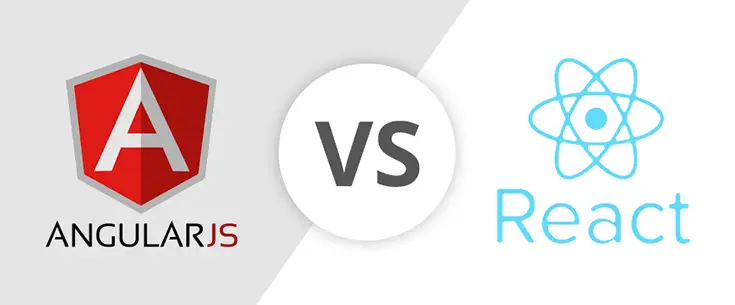Table of Contents
Front-end is an essential part of any application. It facilitates customers’ interaction with an app and works as a shop-front, ensuring its success in the market. Therefore, it’s vital that the front-end has a great app design and is user-friendly to navigate. To address all those issues, front-end developers use various helping tools, libraries and frameworks.
Angular and React.js are considered to be the most popular JavaScript frameworks. The main questions that we cover in this article are which one is better for web and mobile app development, which has better performance, which one l to choose for small and large projects.
Overview of React and Angular
Angular is a JavaScript open-source front-end framework. It’s developed by Google and dates back to 2010. This framework is based on TypeScript, a programming language that originates from JavaScript.
Although Angular has two versions – the first is Angular JS and the second is Angular 2 – when talking about this framework, front-end developers usually mean Angular 2 calling it just Angular. The latest 10th Angular update (Angular 10) was released in June 2020.
Angular is quite wide-spread, such well-known brand names as Forbes, Xbox, McDonald’s, PayPal, Telegram, Nike, and many others utilize Angular for their web app development.
React.js was released by Facebook in 2013 and since then it’s been quite popular among different world-known businesses. Instagram, WhatsApp, Netflix, Uber, Pinterest, and others use React for front-end development.
Many front-end developers argue on what React js is. Some say that it’s a library, others argue that it’s a framework. Wikipedia states that t React (also known as React.js or ReactJS) is a simple open-source JavaScript library. While all frameworks follow the MVC (Model-Viewer-Controller) paradigm, React accounts only for data representation. It means that it stands only for a V letter from MVC abbreviation.
There might be confusion between React and React Native as they are used for different purposes. React.js is mainly used for web development whereas React Native (a stand-alone open-source framework) is used for building mobile applications.
Speed of Development
Angular is an independent framework that provides a wide range of tools and makes the development process easier. It covers all parts of front-end app development from project creation to faster code writing and its optimization and doesn’t require any external tools or extra libraries.
React, in turn, needs adding development libraries such as Redux and React Router for state management, routing, and other basic development functions. As a result, it requires longer configuring and setting up than Angular.
Moreover, before using React developers might need to build an application structure, whereas Angular provides a backbone of code lines for building any web or mobile app. However, fixed Angular’s structure can have a negative effect in the future, as the apps are much harder to scale, while React with its straightforward architecture is much more flexible.
Learning Curve
Angular has a steep learning curve as it goes beyond just knowing a TypeScript programming language. It is versatile and can provide several ways of solving the same problem. Therefore, front-end developers have to acquire a vast volume of information before using it.
Besides its size, for successful Angular use, front-end developers should also learn how to implement the MVC model and Angular sophisticated component management system. Debugging and testing can also be quite difficult in Angular as when developers put different components together instead of coding them, they may miss out on app logic. As a result, searching for fault reasons can take hours.
React is much easier to learn as it provides fewer solutions in comparison to Angular. It requires just good knowledge of JavaScript to use it at once. However, to take full advantage of React, front-end developers have to study some extra libraries such as Redux or MobX for state management, React Router for routing, and how to use a number of API connections. Therefore, React’s learning curve is less steep than Angular’s and mainly depends on the complexity of the features front-end developers want to use in their app development.
Syntax
Angular relies on its three pillars – TypeScript, RxJS, and Zone.js. TypeScript is a superset of JavaScript programming language. It adds types to JavaScript, improving its documentation and code validation. RxJS is a library for reactive programming that allows building an asynchronous code and Zone.js mechanism for tracking asynchronous operations. The mix of these tools makes Angular a robust platform for mobile and web development.
React divides UI into UI components, facilitating the development of visual interfaces. It works only on the presentation layer and renders elements in HTML. To do this, it uses a JSX tool which like TypeScript in Angular combines HTML with JavaScript, hence putting HTML into JavaScript. Besides that, JSX immediately defines any syntax errors by performing static analysis. Being rather simple to use, JSX makes a powerful solution for building React web applications with minimum to none critical and major errors.
Comparing Popularity
When comparing the statistics of Angular and React on different specialized technical sites such as GitHub, Stack Overflow Trends, State of JavaScript, it’s clear that React surpasses Angular by popularity.
Stack Overflow in its Developer Survey put React on top, calling it ‘Most Loved, Dreaded, and Wanted Web Framework’ while Angular was ranked only 9th. Besides that, Stack Overflow has processed the data on the questions asked about React js, Angular, and Vue.js. It appears that React is the most demanded tool, while Angular JS takes the second position.
In State of JavaScript’s statistics, React takes the first place and Angular loses to React and Vue.js when it comes to front-end developers’ awareness, interest, and satisfaction with these front-end development frameworks.
GitHub also states that React wins by many statistical studies. It’s the most downloadable and popular tool among front-end developers.
React’s fame is easily explained. It has a shallow learning curve and can be used immediately, once you’re acquainted with HTML well. Moreover, it’s a powerful and reliable solution, therefore, many front-end development newcomers as well as professionals would opt to React when it comes to web development.
However, it doesn’t mean that web development with Angular is a bad idea. Angular is a full-fledged framework that allows building robust and safe web and mobile apps. It’s less popular as it takes more time to master. Therefore, fewer developers will choose Angular only for building web apps.
Critical Pros and Cons
Angular pros:
- Angular is a comprehensive framework used for web and mobile app development.
- TypeScript unlike JavaScript supports type checking which helps with code debugging.
- With the Angular Language Server, front-end developers can better develop app code as it provides hints on errors and possible completions inside Angular templates.
- Angular supports one-way and two-way data binding which front-end developers can choose depending on their development needs for a particular app.
- Angular supports dependency injection, making code easier to test, read, and reuse.
- Angular has a large community and well-elaborated documentation. Above all, it’s supported by Google which makes this framework a reliable tool for front-end development.
Angular cons:
- Angular takes time to learn as it offers diverse tools such as Injectables, Pipes, Modules, and others.
- Angular performs slower in comparison with React due to the use of the real DOM and two-way data binding. Although with “Change detection Strategy” front-end developers can manually control the process of component rendering.
React pros:
- React is an easy to learn library that allows quickly developing UI interfaces by combining HTML with JavaScript.
- React uses the virtual DOM which improves its performance and productivity.
- Create React App template generator facilitates building Single Page Applications (SPA) as well as Progressive Web Apps (PWA).
- React helps to build easily maintained and scalable apps as it allows building a modularized design and reusable code.
- React supports one-way data-binding which minimizes the number of errors.
- Once you get to grips with React js it gets much easier to learn React Native for mobile app development.
React cons:
- React is highly non-opinionated technology which leaves the development decision in the hands of front-end developers.
- React tries to minimize class-based components in its structure, therefore, it can be challenging for the developers to learn, especially, if they are accustomed to Object-Oriented Programming (OOP).
- It can be hard to keep up with the React documentation due to its often updates.
Summary
Angular and React have their own pros and cons front-end developers need to consider when choosing one of them. However, both solutions work great for developing web applications. With React front-end developers can build lightweight and flexible apps while Angular provides a well-grounded development basis with a variety of approaches to one problem. Above all, Angular works great for mobile app development.
The two tools don’t remain static and are constantly upgraded by Google and Facebook, improving their performance and development capabilities. So, which tool to choose in 2020? Here is our quick check-list that could facilitate your choice:
| Go for Angular if: | Go for React if: |
|
|




This article’s starting was good with correct facts but later mixed the facts and myths together. Below are points which are to be corrected in this article –
Learning -> Learning basics of Angular/React/Vue are the same. Learning additional things like using routes, stores(Angular doesn’t need any store), forms takes time. That means learning time are also similar. However, Angular requires familiarity of TypeScript, which could be learnt in just 15-30 mins if you already know JavaScript(though having knowledge of typed languages give extra edge).
Scaling -> Angular is much easier to scale due to its pre-defined modular structure. Also, unlike ReactJS projects, all Angular developers follow similar structure resulting in ease of understanding for a new team member.
Popularity and tools -> Ionic supported only Angular and has recently started supporting React/Vue/JS. NativeScript can be used for more performant(soo called) apps. Angular’s structure is soo popular that even NestJS supports it in server-side development.
Speed -> Speed of Angular and React apps on average are similar. Also, interim DOM takes way too memory efficient than VDOM.
All those pros from React side are applicable in Angular side as well.
Hi Sujit,
thanks a lot for your feedback, I really appreciate it!
Being an Angular developer myself, I agree with most (if not all) of your points: I’ll keep the author posted so maybe she can fix or rephrase them :)
I feel somehow you just contradicted yourself in this article in the Pros and Cons section saying React is easier to learn than Angular. But then as a Con you say its hard to learn. So which is it, is it hard or easy to learn? Personally, I find React kind of messy with its functional paradigm and like the opinionated nature of Angular, but React does have many bonuses. The functional paradigm can also be a strong point, but I find a pure functional approach for such a comprehensive framework to have potential problems with enterprise sized applications and scalability. Of course, React has lots of third party libraries and plug-ins. But ,as in the Java world, many plug-ins and additional libraries can also create chaos as well as benefits of versatility. Sometimes it is nice to have the core of the framework supported by a large corporation (like Google).
I am coming from a .Net developer perspective, YMMV.